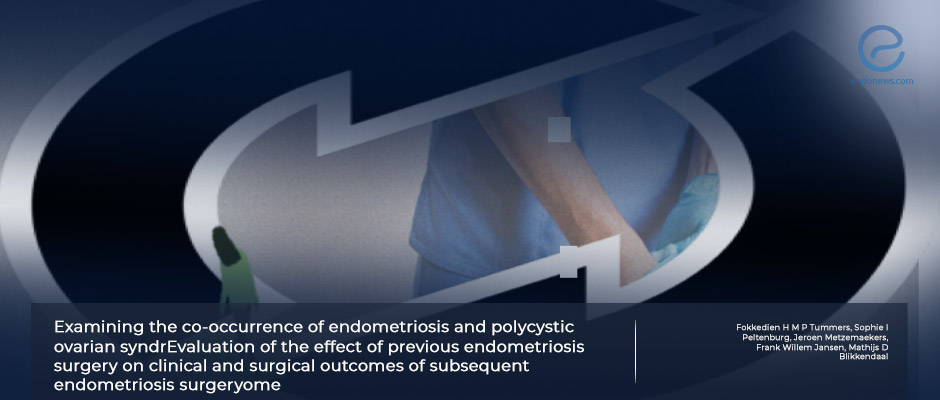No increased risk of major postoperative complications in women operated by experienced surgeons in endometriosis centers
Nov 3, 2023
The need for repeat surgery is a common phenomenon in the patient journey of women with endometriosis
Key Points
Highlights:
- If endometriosis surgery is performed by experienced surgeons in qualified endometriosis centers, there is no increase in the risk of postoperative complications during recurrent surgery.
Importance:
- Women undergoing endometriosis surgery should be informed about the risk of recurrent surgery.
What’s done here?
- This retrospective monocentre cohort study was conducted to evaluate the effect of previous endometriosis surgeries on subsequent surgical outcomes.
- The study group consisted of patients with previous endometriosis surgery, the control group included women without previous endometriosis surgery.
- Surgical characteristics in the previous surgery such as the total number of surgeries and for every surgery, the year, indication (endometriosis-related or not), and modality (laparoscopic vs. laparotomic and diagnostic vs. therapeutic) were analyzed.
- Type of endometriosis treated, rASRM and Enzian scores, intraoperative steps, intraoperative complications, postoperative major complications, and surgical time in index surgery were reported.
- Intestinal procedures, urological procedures, hysterectomy, and adhesiolysis were evaluated as intraoperative steps.
- Intraoperative complications were categorized into vascular, visceral, or urinary tract injury or other complications.
- Postoperative complications were recorded according to the Clavien–Dindo classification.
Key results:
- A total of 595 patients who met the eligibility criteria were included, 46%) had previous endometriosis surgery while 54%) were in the control group.
- Women were found to be significantly older and body mass index was significantly higher in the study group.
- Previous endometriosis surgeries were performed laparoscopically in 352 patients (86%) and therapeutically in 297 patients (72%).
- There was NO significant difference in terms of the endometriosis classifications (rASRM and ENZIAN) between the patients with and without previous endometriosis surgery.
- Adhesiolysis was needed more often in the group with previous laparotomic and laparoscopic endometriosis surgery.
- A significant association with increased surgical time was observed with previous therapeutic laparotomic endometriosis surgery.
- Women undergoing previous endometriosis surgery were more prone to have intraoperative complications, especially urinary tract injury.
- Any other previous surgeries showed no association with major post-operative complications.
Strengths and Limitations
- Being the first paper to evaluate the detailed effect of previous surgeries on surgical outcomes is the most important strength of this study.
- Retrospective design and the absence of detailed information regarding previous surgeries and the interval to recurrent surgeries are limitations.
Lay Summary
Recurrent surgery may be needed in up to 35% of endometriosis patients. The reason for repeated surgery may be residual or recurrent disease. In other words, multiple surgical procedures are a common phenomenon for women having endometriosis.
Knowing the impact of previous surgeries on subsequent surgeries is so important to provide correct counseling to the patient and to make preoperative planning. Tummers et al. from Netherlands published a study titled “Evaluation of the effect of previous endometriosis surgery on clinical and surgical outcomes of subsequent endometriosis surgery” in the journal Archives of Gynecology and Obstetrics.
The authors aimed to assess the effect of previous endometriosis surgeries on subsequent surgical outcomes. They analyzed the patients who underwent endometriosis surgery as the study group and those without previous surgery as the control group. They compared demographic and surgical characteristics between the two groups such as type of endometriosis treated, rASRM and Enzian scores, intraoperative steps, intraoperative complications, postoperative major complications, and surgical time.
The authors reported that there was a significant association between previous therapeutic laparotomic endometriosis surgery and longer surgical time, the need to perform adhesiolysis, and more intraoperative complications in the subsequent surgery for endometriosis. They also did not find any significant increased risk for major postoperative complications.
Additionally, the association between previous therapeutic laparoscopic endometriosis surgery and both laparoscopic and laparotomic non-endometriosis surgeries and all outcome measures was not detected.
“In a centre of expertise with experienced surgeons, no increased risk of major post-operative complications was observed,” they added.
Research Source: https://pubmed.ncbi.nlm.nih.gov/37639036/
endometriosis repeat surgery complications patient journey recurrence intraoperative complications postoperative complications

